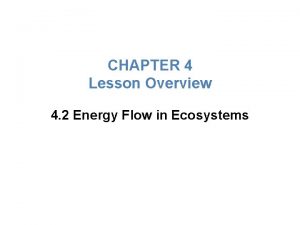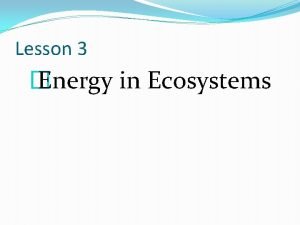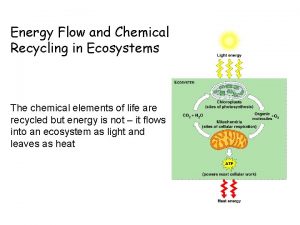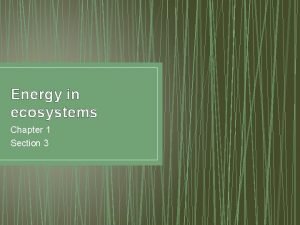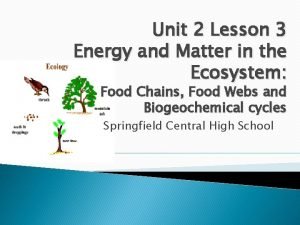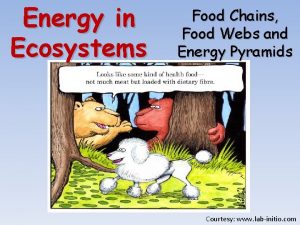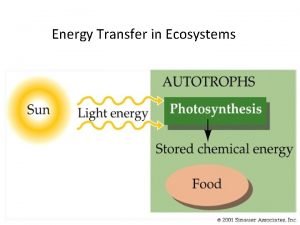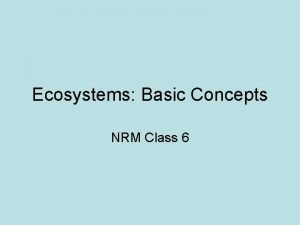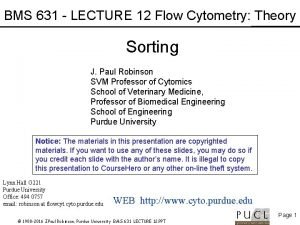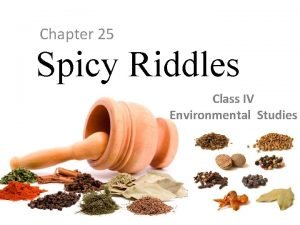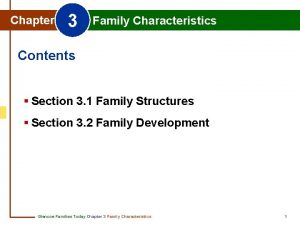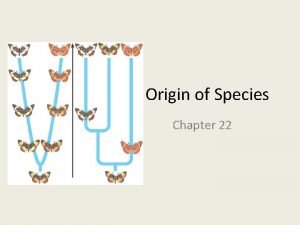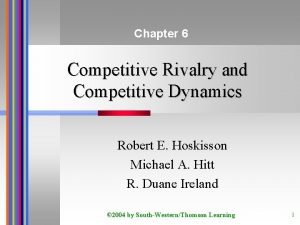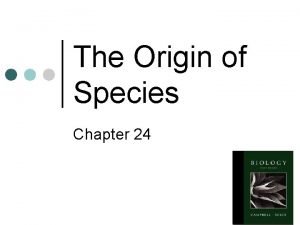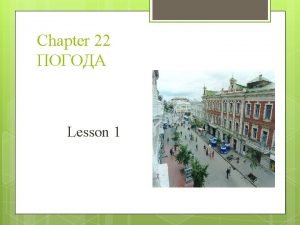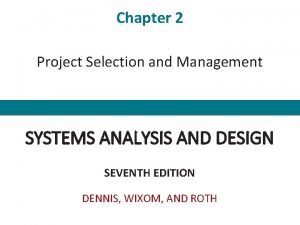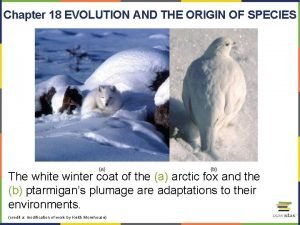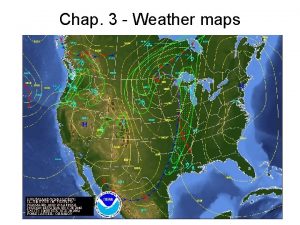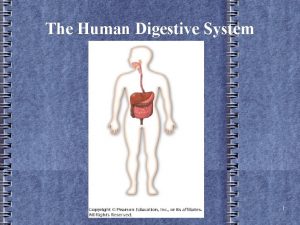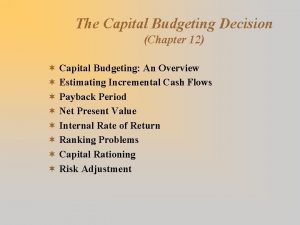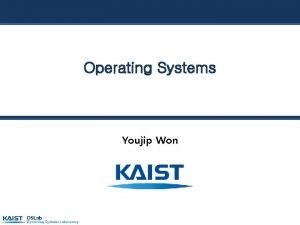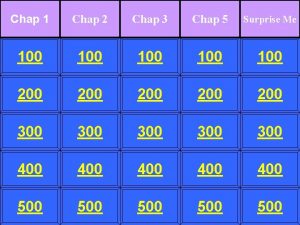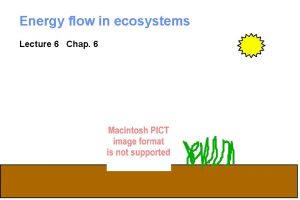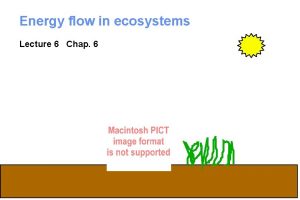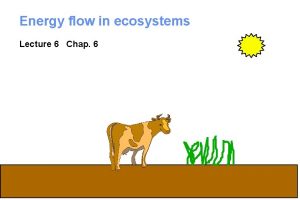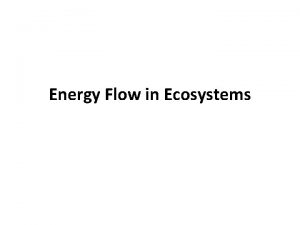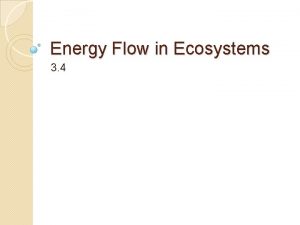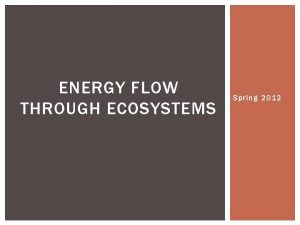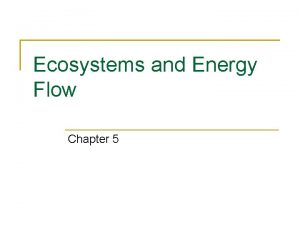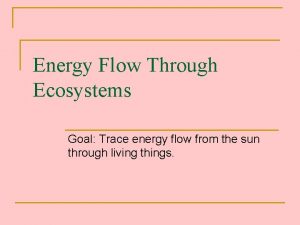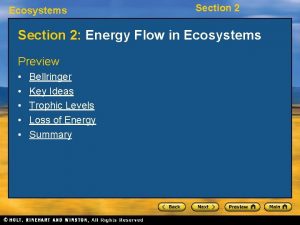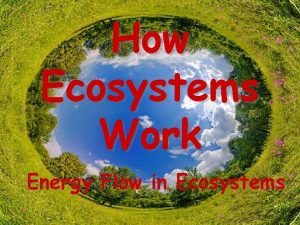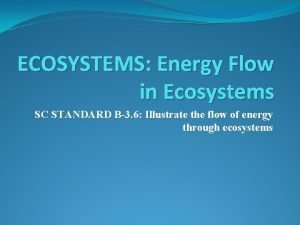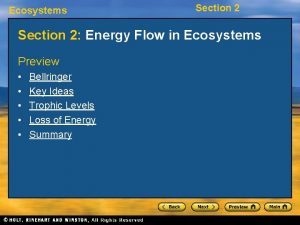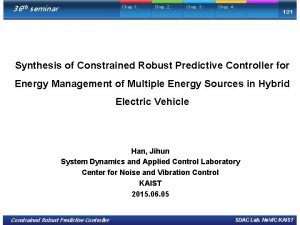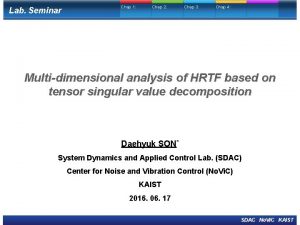Energy flow in ecosystems Lecture 6 Chap 6



















































- Slides: 51

Energy flow in ecosystems Lecture 6 Chap. 6 1

What is an ecosystem? System = regularly interacting and interdependent components forming a unified whole Ecosystem = an ecological system; = a community and its physical environment treated together as a functional system 2

OR, MORE SIMPLY an ecosystem is composed of the organisms and physical environment of a specified area. SIZE: micro to MACRO 3

THE RULES OF ECOLOGY F. A. BAZZAZ: 1. Everything is connected to everything else. 2. Everything must go somewhere. 3. There is no such thing as a free lunch. 4

H. T. Odum: To understand any system you must understand the next larger system. 5

Attributes of Ecosystems Order Development Metabolism (energy flow) Material cycles Response to the environment Porous boundaries Emphasis on function, not species 6

ENERGY FLOW IN ECOSYSTEMS All organisms require energy, for growth, maintenance, reproduction, locomotion, etc. Hence, for all organisms there must be: A source of energy A loss of usable energy 7

Types of energy heat energy mechanical energy (+gravitational energy, etc. ) chemical energy = energy stored in molecular bonds 8

Transformations of energy How is solar energy converted to chemical energy? How does this process influence life as we see it on earth? The transformations of energy from solar radiation to chemical energy and mechanical energy and finally back to heat are a traditional topic of Ecosystem Ecology. 9

An ecosystem has abiotic and biotic components: ABIOTIC components: Solar energy provides practically all the energy for ecosystems. Inorganic substances, e. g. , sulfur, boron, tend to cycle through ecosystems. Organic compounds, such as proteins, carbohydrates, lipids, and other complex molecules, form a link between biotic and abiotic components of the system. 10

BIOTIC components: The biotic components of an ecosystem can be classified according to their mode of energy acquisition. In this type of classification, there are: Autotrophs and Heterotrophs 11

Autotrophs (=self-nourishing) are called primary producers. Photoautotrophs fix energy from the sun and store it in complex organic compounds (= green plants, algae, some bacteria) light simple inorganic compounds photoautotrophs complex organic compounds 12

Chemoautotrophs (chemosynthesizers) are bacteria that oxidize reduced inorganic substances (typically sulfur and ammonia compounds) and produce complex organic compounds. oxygen reduced inorganic compounds chemoautotrophs complex organic compounds 13

Chemosynthesis near hydrothermal vents 14

Other chemoautotrophs: Nitrifying bacteria in the soil under our feet! 15

Heterotrophs (=other-nourishing) cannot produce their own food directly from sunlight+ inorganic compounds. They require energy previously stored in complex molecules. heat complex organic compounds heterotrophs (this may include several steps, with several different types of organisms) simple inorganic compounds 16

Heterotrophs can be grouped as: consumers decomposers 17

Consumers feed on organisms or particulate organic matter. Decomposers utilize complex compounds in dead protoplasm. Bacteria and fungi are the main groups of decomposers. Bacteria are the main feeders on animal material. Fungi feed primarily on plants, although bacteria also are important in some plant decomposition processes. 18

19

The Laws of Thermodynamics Energy flow is a one-directional process. sun---> heat (longer wavelengths) FIRST LAW of THERMODYNAMICS: Energy can be converted from one form to another, but cannot be created or destroyed. 20

SECOND LAW of THERMODYNAMICS Transformations of energy always result in some loss or dissipation of energy or In energy exchanges in a closed system, the potential energy of the final state will be less than that of the initial state or Entropy tends to increase (entropy = amount of unavailable energy in a system) or Systems will tend to go from ordered states to disordered states (to maintain order, energy must be added to the system, to compensate for the loss of energy) 21

Examples Internal combustion engines in cars are 25% efficient in converting chemical energy to kinetic energy; the rest is not used or is lost as heat. My house, particularly my girls' rooms, goes from a complex, ordered state to a simpler, disordered state. 22

Energy flow Simplistically: heat Producers Consumers Decomposers heat This pattern of energy flow among different organisms is the TROPHIC STRUCTURE of an ecosystem. 23

It is useful to distinguish different types of organisms within these major groups, particularly within the consumer group. Consumers 24

Terminology of trophic levels We can further separate the TROPHIC LEVELS, particularly the Consumers: Producers (Plants, algae, cyanobacteria; some chemotrophs)--capture energy, produce complex organic compounds Primary consumers--feed on producers Secondary consumers--feed on primary consumers Tertiary consumers--feed on secondary consumers 25

More trophic levels: Detritivores--invertebrates that feed on organic wastes and dead organisms (detritus) from all trophic levels Decomposers--bacteria and fungi that break down dead material into inorganic materials 26

Alternate Terminology Producers = plants etc. that capture energy from the sun Herbivores = plant-eaters Carnivores = animal-eaters Omnivores--eat both animals and plants Specialized herbivores: Granivores--seed-eaters Frugivores--fruit-eaters 27

Together, these groups make up a FOOD CHAIN E. g. , grass, rabbit, eagle Carnivore Herbivore Producer 28

Carnivores can be further divided into groups: quaternary carnivore tertiary carnivore secondary carnivore primary carnivore (top) The last carnivore in a chain, which is not usually eaten by any other carnivore, is often referred to as the top carnivore. 29

Food chains 30

Problems Too simplistic No detritivores Chains too long 31

Rarely are things as simple as grass, rabbit, hawk, or indeed any simple linear sequence of organisms. More typically, there are multiple interactions, so that we end up with a FOOD WEB. 32

33

Energy transfers among trophic levels How much energy is passed from one trophic level to the next? How efficient are such transfers? 34

Biomass--the dry mass of organic material in the organism(s). (the mass of water is not usually included, since water content is variable and contains no usable energy) Standing crop--the amount of biomass present at any point in time. 35

Primary productivity is the rate of energy capture by producers. = the amount of new biomass of producers, per unit time and space 36

Gross primary production (GPP) = total amount of energy captured Net primary production (NPP) = GPP - respiration Net primary production is thus the amount of energy stored by the producers and potentially available to consumers and decomposers. 37

Secondary productivity is the rate of production of new biomass by consumers, i. e. , the rate at which consumers convert organic material into new biomass of consumers. Note that secondary production simply involves the repackaging of energy previously captured by producers--no additional energy is introduced into the food chain. And, since there are multiple levels of consumers and no new energy is being captured and introduced into the system, the modifiers gross and net are not very appropriate and are not usually used. 38

Ecological pyramids The standing crop, productivity, number of organisms, etc. of an ecosystem can be conveniently depicted using “pyramids”, where the size of each compartment represents the amount of the item in each trophic level of a food chain. carnivores herbivores producers Note that the complexities of the interactions in a food web are not shown in a pyramid; but, pyramids are often useful conceptual devices--they give one a sense of the overall form of the trophic structure of an ecosystem. 39

Pyramid of energy A pyramid of energy depicts the energy flow, or productivity, of each trophic level. Due to the Laws of Thermodynamics, each higher level must be smaller than lower levels, due to loss of some energy as heat (via respiration) within each level. Energy flow in : carnivores herbivores producers 40

Pyramid of numbers A pyramid of numbers indicates the number of individuals in each trophic level. Since the size of individuals may vary widely and may not indicate the productivity of that individual, pyramids of numbers say little or nothing about the amount of energy moving through the ecosystem. # of carnivores # of herbivores # of producers 41

Pyramid of standing crop A pyramid of standing crop indicates how much biomass is present in each trophic level at any one time. As for pyramids of numbers, a pyramid of standing crop may not well reflect the flow of energy through the system, due to different sizes and growth rates of organisms. biomass of carnivores biomass of herbivores biomass of producers (at one point in time) 42

Inverted pyramids A pyramid of standing crop (or of numbers) may be inverted, i. e. , a higher trophic level may have a larger standing crop than a lower trophic level. This can occur if the lower trophic level has a high rate of turnover of small individuals (and high rate of productivity), such that the First and Second Laws of Thermodynamics are not violated. biomass of carnivores biomass of herbivores biomass of producers (at one point in time) 43

Pyramid of yearly biomass production If the biomass produced by a trophic level is summed over a year (or the appropriate complete cycle period), then the pyramid of total biomass produced must resemble the pyramid of energy flow, since biomass can be equated to energy. Yearly biomass production (or energy flow) of: carnivores herbivores producers 44

Note that pyramids of energy and yearly biomass production can never be inverted, since this would violate the laws of thermodynamics. Pyramids of standing crop and numbers can be inverted, since the amount of organisms at any one time does not indicate the amount of energy flowing through the system. E. g. , consider the amount of food you eat in a year compared to the amount on hand in your pantry. 45

Examples of food webs the North Sea a hypothetical web--effects on species diversity 46

7 -12 mm 13 -40 mm 40 -130 mm Adult Herring in the North Sea 47

a hypothetical web--effects on species diversity 48

Examples of pyramids Terrestrial and fresh-water communities Ocean communities--English Channel 49

50

51
 Chap chap slide
Chap chap slide Chapter 4 lesson 2 energy flow in ecosystems
Chapter 4 lesson 2 energy flow in ecosystems Which marine ecosystem contains the fewest producers
Which marine ecosystem contains the fewest producers Energy flow and chemical recycling in ecosystems
Energy flow and chemical recycling in ecosystems Primary consumer definition
Primary consumer definition Section 1 energy flow in ecosystems
Section 1 energy flow in ecosystems 01:640:244 lecture notes - lecture 15: plat, idah, farad
01:640:244 lecture notes - lecture 15: plat, idah, farad Energy naturally flows from warmer matter to cooler matter.
Energy naturally flows from warmer matter to cooler matter. Flow of energy vs flow of matter
Flow of energy vs flow of matter Section 3 energy in ecosystems
Section 3 energy in ecosystems Chapter 42 ecosystems and energy
Chapter 42 ecosystems and energy Energy flow trophic levels
Energy flow trophic levels Phosphorus cycle
Phosphorus cycle Lab food chains and energy in ecosystems
Lab food chains and energy in ecosystems How does energy move through most ecosystems on earth
How does energy move through most ecosystems on earth Ecosystem energy transfer
Ecosystem energy transfer Food chain for class 6
Food chain for class 6 Flow cytometry lecture
Flow cytometry lecture Energy energy transfer and general energy analysis
Energy energy transfer and general energy analysis Energy energy transfer and general energy analysis
Energy energy transfer and general energy analysis Style chapter 1
Style chapter 1 Passion chap 6
Passion chap 6 Bank run chap 11
Bank run chap 11 Durbin chap
Durbin chap Spice riddle
Spice riddle Kstn chap 18
Kstn chap 18 Characteristics of family
Characteristics of family Origin of species chapter 18
Origin of species chapter 18 Satifying needs
Satifying needs The origin of species manga ch 22
The origin of species manga ch 22 Mad dog ch 25
Mad dog ch 25 If thy right hand offend thee
If thy right hand offend thee Kinds in development chap 1
Kinds in development chap 1 Rivalry 1 ch 6
Rivalry 1 ch 6 System engineer chap 1
System engineer chap 1 Chap tree
Chap tree Kstn chap 7
Kstn chap 7 I was in that state when a chap easily turns nasty analysis
I was in that state when a chap easily turns nasty analysis The origin of species chap 24
The origin of species chap 24 Passion chap 9
Passion chap 9 Bài tập về nhà
Bài tập về nhà In the summer chap 22
In the summer chap 22 What are the project selection methods
What are the project selection methods The origin of species manhwa chapter 18
The origin of species manhwa chapter 18 Friendly relationship chapter 12
Friendly relationship chapter 12 Fitness ch 1
Fitness ch 1 Chap tree
Chap tree Surface weather station model
Surface weather station model Chap 23
Chap 23 Payback chap 12
Payback chap 12 Chapter 1 why personal fitness
Chapter 1 why personal fitness Youjup
Youjup

